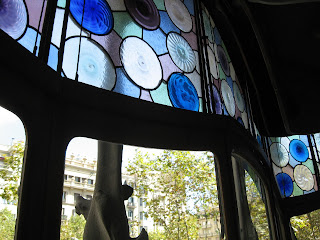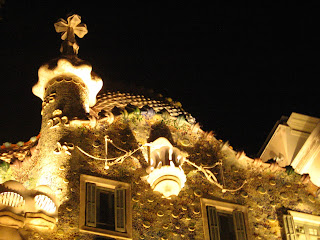
On Passeig de Gracia, this is the most awe-inspiring attraction: the house of bones - with skull-like balconies and snail-shaped ceilings or staircases. A sophisticated mix of creativity, symbolism, and eclectism. The Art Nouveau organic, flowing design is intertwined with Moorish-style tile-cladding and Christian motifs.
The curved roof is associated with the back of a dragon - not just any dragon, but the one pierced by Saint George with a cross-shaped spear. Taken as a whole, the motifs compose after all an optimistic image of death (the skulls) and destruction (the dragon) being defeated by the divine force of God (the cross of Saint George, also the patron of Catalonia). The wavy shape of the roof, as opposed to the regular lines of the tower, reflects the antagonism between Christian cosmos and demonic chaos, revealing Gaudi's religiosity.
Another possible interpretation could be that this building expresses an architectural standpoint - no matter how humble or how great, houses, as dwellings, are nothing less but a natural extension of their inhabitant's body, hence the organic appearance, a space that sustains human life and activity as the skeleton sustains our organism.




 |
| Courtyard and stairwell tile-cladding |
 |
| Pictures from the noble floor and museum |
 |
| Doors and furniture designed by Gaudi |
 |
| Stained glass |
 |
| Moorish-tile cladding of the stairwell |
 |
| The loft |
 |
| Chimneys |
 |
| View over the rooftop |
 |
| The Dragon's spine and scales |
 |
The cross of four-arms indicating cardinal points,
with the monograms of Jesus, Virgin Mary, and Saint Joseph |
 |
| Views over Paseig de Gracia |
 |
| View from the balcony |
 |
| Detail from the loft |
 |
| Moorish tiles covering the stairwell |
 |
| Oak-wooden door designed by Gaudi |
 |
| Water-lilies facade |



































































